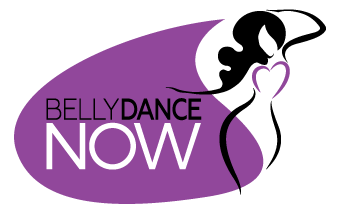Free Zoom for teaching
February 13th, 2023Dear Dancers
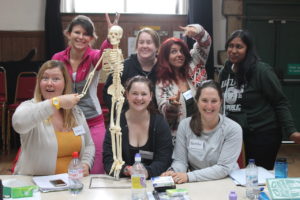 We are about to start our next round of teacher training. Our Level 1 bellydance teaching certification starts soon. If you are new to teaching – or are thinking about teaching this could make all the difference. Join us for the FREE Zoom session to find out more about the course, what it involves and what it will do for you.
We are about to start our next round of teacher training. Our Level 1 bellydance teaching certification starts soon. If you are new to teaching – or are thinking about teaching this could make all the difference. Join us for the FREE Zoom session to find out more about the course, what it involves and what it will do for you.
Saturday 25th February 2023
3pm
Book your place on this free zoom call about teaching bellydance. It is free but you have to book your place to get the Zoom link. If you can’t join us live, book anyway and I will send the recording link out after.
Or if you just want to check out the details and book your place go straight to our booking page ‘L1 teaching certification’
If you teach bellydance join our facebook group – a place to post things for other teachers, ask questions and get support. Join the BDN teaching community.
Teaching can be a lonely job – we create classes and pour our energies into them to ensure our students have a great time. Often that energy is reciprocated and we feel energised by the class too. Sometimes though we expend too  much energy, feel drained and need some inspiration or input ourselves. At BellyDance Now, we are developing a resource area for teachers which will have a small monthly fee but we hope will give a you a source of ideas, practical information and things to inspire you. Thanks to those of you who completed the survey to say what you would find useful. We hope to launch this by Easter. We will post details on the BDN teaching community group on FB. We already host Zoom networking events for teachers to get together. We also invite specialists to talk at these events on subjects specifically of interest to teachers. These are held ‘live’ and then posted onto this resource area.
much energy, feel drained and need some inspiration or input ourselves. At BellyDance Now, we are developing a resource area for teachers which will have a small monthly fee but we hope will give a you a source of ideas, practical information and things to inspire you. Thanks to those of you who completed the survey to say what you would find useful. We hope to launch this by Easter. We will post details on the BDN teaching community group on FB. We already host Zoom networking events for teachers to get together. We also invite specialists to talk at these events on subjects specifically of interest to teachers. These are held ‘live’ and then posted onto this resource area.
Thus far we have inspirational talks from:
Randa Kamel
Julia Farid
Tare Lee Oakley
We have had really useful talks
Nikki Taplin – Marketing
Stuart at Sound Dynamics – zoom kit and sound advice
Louise Cardon – Life coach – dealing with covid and uncertainty
And many more subjects too.
We also have little technique / combinations for you to browse through. To use or adapt if you run out of steam.
Ideas for class content
Practical information too
As teachers it is nice to know there is something there for us and a network of other teachers to turn to.
Holding Student Attention with Julia Farid
November 23rd, 2022This networking event was free to all bellydance teachers. Julia Farid is an amazing dancer and teacher. It was great to get an insight into her techniques and teaching philosophy.
Join the BellyDance Now teaching team and complete our Safety course – in depth and fascinating – it will inform how you teach forever. Full details of our safety course here.
Carmens top 3 European dancers …….
October 10th, 2022 Katia Eshta’s elite team of bellydancers (if you don’t know Katia Eshta, have a little google search for “Cairo Mirage” which is probably the best bellydance festival I have ever been to). She is a gorgeous siren, curvy, flirty, cracking technique, impossible outfits and head to toe superstar. You’ll find her in Cairo, wearing top designer costumes,
Katia Eshta’s elite team of bellydancers (if you don’t know Katia Eshta, have a little google search for “Cairo Mirage” which is probably the best bellydance festival I have ever been to). She is a gorgeous siren, curvy, flirty, cracking technique, impossible outfits and head to toe superstar. You’ll find her in Cairo, wearing top designer costumes,  dancing at weddings and usually with her sidekick and also cracking bellydancer Margarita (another of Katia’s super bellydance team). Kristina is snakey and fast paced, with a very unique style… but a complete delight to watch.
dancing at weddings and usually with her sidekick and also cracking bellydancer Margarita (another of Katia’s super bellydance team). Kristina is snakey and fast paced, with a very unique style… but a complete delight to watch. She glides on stage, soft and elegant but ever so powerful. She turns beautifully and she’s simply head to toe bellydance perfection. You can find her in Ukraine, she has her own festival and has been a teacher to some of the most popular dancers in the scene (Anna Chepets) and a lot of the competition winners in the competition circuit. If you can, you should definitely get a lesson with her because her technique is so on point and beautiful she will give you a lot to take home and work with.
She glides on stage, soft and elegant but ever so powerful. She turns beautifully and she’s simply head to toe bellydance perfection. You can find her in Ukraine, she has her own festival and has been a teacher to some of the most popular dancers in the scene (Anna Chepets) and a lot of the competition winners in the competition circuit. If you can, you should definitely get a lesson with her because her technique is so on point and beautiful she will give you a lot to take home and work with. Darina is your bellydance rebel. She doesn’t play by any bellydance “rules”. She takes bellydance to the next level. She has such a wide range of technique, she is trained in salsa,ballet, she has a hip hop flare and her choreographies are unique a powerful. She is strong, knows everything about muscle work and even though she isn’t strictly your “oriental dancer” she is definitely one that you should not miss out on. Impossible backbends, hair tossing, leg extensions, strong accents… learning with Darina is like an intense gym session (that is 100% completely worth it).
Darina is your bellydance rebel. She doesn’t play by any bellydance “rules”. She takes bellydance to the next level. She has such a wide range of technique, she is trained in salsa,ballet, she has a hip hop flare and her choreographies are unique a powerful. She is strong, knows everything about muscle work and even though she isn’t strictly your “oriental dancer” she is definitely one that you should not miss out on. Impossible backbends, hair tossing, leg extensions, strong accents… learning with Darina is like an intense gym session (that is 100% completely worth it).Join Carmen for her lecture at Fantasia on Instagram dancers you should follow.
Bellydance Now Teachers Networking with Randa
August 15th, 2022At Bellydance Now we provide free networking events for bellydance teachers. These are designed to inform and inspire – and bring us together to develop a teaching community.
We also design and deliver courses specially for dancers passionate about bellydance. Randa recommends watching films – you might want to try our new course with 11 Egyptian films all featuring dancers. Yasmina summarises the plot and analyses each one to help us better understand the cultural context. ‘Bellydancers on Film’
Big ‘Thank you’ to Randa for joining us – and Sara and Sherif for helping make it possible.
Who is Abeer Will?
August 10th, 2022I first met Abeer in Cairo at the atelier of costumier Hanan Mahmoud. Hanan had kept telling me about Abeer over the years but we had never actually met. We hit it off straight away. I love her down to earth nature and her sense of humour. We 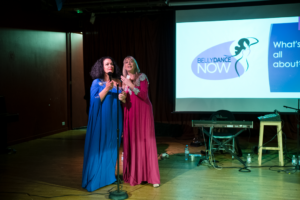 worked together a few times through lockdown over Zoom and she decided to come over to the UK to support the launch of ‘Bellydance Now’. Abeer is a font of knowledge and has helped build and develop the dance community in the region of Germany where she now lives. I felt we had so many aims in common I suggested to the other directors of BDN that Abeer join the team. She bring an Egyptian perspective to our ventures as well as an in depth knowledge of traditional dance in Egypt. (Picture: Abeer & Kay introducing BDN)
worked together a few times through lockdown over Zoom and she decided to come over to the UK to support the launch of ‘Bellydance Now’. Abeer is a font of knowledge and has helped build and develop the dance community in the region of Germany where she now lives. I felt we had so many aims in common I suggested to the other directors of BDN that Abeer join the team. She bring an Egyptian perspective to our ventures as well as an in depth knowledge of traditional dance in Egypt. (Picture: Abeer & Kay introducing BDN)
This is how Abeer has been described by dancers who have worked with her: ‘She is simply Cairo!!!’ ‘Explosive, impulsive, passionate and with a lot of female pride – this is how Abeers style can be aptly describes’, ‘Abeer brings us closer to that pure Egyptian feeling through her dance and teaching’.
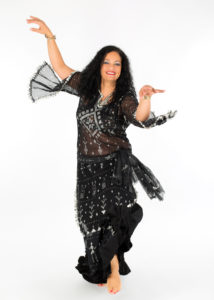 Abeer in Egypt:
Abeer in Egypt:
Abeer comes from Alexandria and studied as an agricultural engineer. In addition to her studies, Abeer completed dance training at her university in Alexandria and at the state dance theatre, Zagazig. She worked as a dancer at various theatres in Cairo as well as on European tours. In 1995 she began teaching in Germany and opened a dance studio in Hildesheim (Tanzstudio BAHIA) in 1996.
Dance Teacher:
Abeer started teaching in Germany and says she has the best of both worlds: An intimate understanding of Egyptian dance laced with the discipline and structure of a European teacher. Since 2004 Abeer has been training German dancers to teach and co-ordinating training content for the BATO training certificate. Abeer also worked as a dance and movement therapist in 2011 and uses some of these principles to inform her teaching. Abeer travels as a guest lecturer and dance teacher through Germany, France, USA and Egypt. She is always in demand because of her warm hearted, generous and knowledgeable teaching manner.
Performer:
In 2007 she worked with the world-renowned choreographer Ismael Ivo on the  project “Mercato del Corpo” for “La Biennale di Venezia”. Abeer was the representative of Oriental Dance. She had several performances through this event together with 6 artists from different nations. An international experience that influenced her development as a dancer and teacher of oriental dance and Egyptian folklore. In Germany she has done theatre work creating and performing in various pieces of choreography for New Year concerts commissioned by the General Music Director, Werner Seitzer. When Abeer teaches at festivals she loves to perform and bring that quintessential Egyptian feel to her dances. Her roots lie in folklore, her love is presenting this dance in an authentic manner with passion and respect.
project “Mercato del Corpo” for “La Biennale di Venezia”. Abeer was the representative of Oriental Dance. She had several performances through this event together with 6 artists from different nations. An international experience that influenced her development as a dancer and teacher of oriental dance and Egyptian folklore. In Germany she has done theatre work creating and performing in various pieces of choreography for New Year concerts commissioned by the General Music Director, Werner Seitzer. When Abeer teaches at festivals she loves to perform and bring that quintessential Egyptian feel to her dances. Her roots lie in folklore, her love is presenting this dance in an authentic manner with passion and respect.
Abeer is coming to the UK to teach twice in 2022:
At the JWAAD Summer School August 2022. It is not too late to book – an amazing residential week with Abeer and many other great teachers.
And at Fantasia Festival 26th November 2022 along with Kareem Gad and Yasmina of Cairo.
I can highly recommend Abeer. She is a font of knowledge. Join her at one of these events.
Kay Taylor
Dancing to Live Music by Yasmina of Cairo
July 31st, 2022I remember very well the first time I danced to music played live by Egyptian musicians. Clutching my cassette tape (yes, it was a long time ago!) I appeared in my costume at the private party I was performing at for an Arab audience in  London, and was told to put it away. It would be insulting, and perhaps even cowardly, they insinuated, not to dance to the live band. ‘Watch the first dancer,’ they suggested, thinking I could pick up some ideas. So I did, feeling very insecure. When they asked her what she would like them to play, she uttered the (to me) intimidating words ‘Oh, anything, I don’t mind!’
London, and was told to put it away. It would be insulting, and perhaps even cowardly, they insinuated, not to dance to the live band. ‘Watch the first dancer,’ they suggested, thinking I could pick up some ideas. So I did, feeling very insecure. When they asked her what she would like them to play, she uttered the (to me) intimidating words ‘Oh, anything, I don’t mind!’
How amazing, I thought, to have such confidence. And she was a foreigner, like me. I don’t remember much about my performance that night (I got through it and no doubt the audience was polite), but as time went on and I began working at a club with a live Egyptian band, the fear faded and my own confidence grew. And then finally, after working for years around the Middle East and Egypt, I discovered that my feeling had reversed: I dreaded performing on stages to a CD, without the energy and security of having musicians behind me.
Of course if you have the luxury of collaborating with the same musicians over time then that is the ultimate way of becoming a blended creative force. But what if this is not the case? You arrive at a show and the musicians are strangers? Or it’s a house band and you are the one that’s unfamiliar to them? It’s important straight away to be clear about what you want, and to remember that they will usually be as keen as you are to present something that shows off your talent and will entertain the audience. Their job is to give life and energy to your performance, just as it is your job to express the beauty of their music with your dance.
Dancing successfully to live music, I think, requires what might seem like two almost opposing things from a dancer: Lots of preparation, and the ability to let go and just go with the flow. These two things are in fact not only compatible, but interdependent. Going with the flow requires you to respond to exactly what you are hearing in the present moment. But you absolutely need the tools with which to do that, which is where technique and hard work are really important.
Preparation
When you know you will be dancing to live music, there is a lot you can do to prepare. Make your Arabic and Egyptian music collection your background 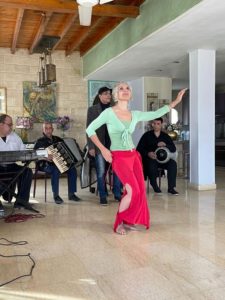 soundtrack and listen to lots of it. Let your ears absorb the melodies and rhythms of each piece until you can sing them in your head, but also take the time to dance in your head: sit or lie down, close your eyes and focus on the music. Do a virtual reality performance, imagining the moves you will make. Then do it again, with a different set of moves or use of your virtual stage. This is important because when the musicians play it it’s unlikely to sound exactly like you’ve heard it on a recording. These days the chances are you will be able to listen to different recordings of the same song, which will also serve to reassure you that the basic melody and structure of the song will be the same on each, even if the instrumentation varies.
soundtrack and listen to lots of it. Let your ears absorb the melodies and rhythms of each piece until you can sing them in your head, but also take the time to dance in your head: sit or lie down, close your eyes and focus on the music. Do a virtual reality performance, imagining the moves you will make. Then do it again, with a different set of moves or use of your virtual stage. This is important because when the musicians play it it’s unlikely to sound exactly like you’ve heard it on a recording. These days the chances are you will be able to listen to different recordings of the same song, which will also serve to reassure you that the basic melody and structure of the song will be the same on each, even if the instrumentation varies.
On the subject of instrumentation, a huge benefit of dancing to live music is that, so long as there are several instruments making up the band, you can choose which ones will lead the melody, enabling you to ‘customize’ a song the way you would like it. So for example if you are dancing to an instrumental version of a classic song, you can ask for the violin to play the vocal track instead of the singer, lending a keenly emotional edge to it. Or the kanoun or oud (one or the other; unless it’s a large orchestra there are unlikely to be both, even in Cairo) to play a more acoustic version of the vocal track, giving it a softer, more pared down feeling.
Leading into the song you could ask for a taksim by one or more of the instruments – something a CD will rarely offer you. And even if it does, it will not have that combination of the feelings of the musician as he plays the taksim in that particular moment, on that particular day, and your response to it as you move. That unique expression of feeling and dual energy created together in real time is something you can only have with live music.
Repetition
Repetition is an important characteristic of Arabic music, and indeed, of Egyptian  dance. Having the confidence to repeat a movement without worrying the audience will be bored by it, or think that your repertoire is too limited, should stop you from making it too busy or frenetic. When a singer feels the audience has really enjoyed a phrase they may well repeat it, and if you are dancing to it they may indicate this to you also. Such a live interaction between the audience and the musicians and dancer gives a wonderful sense of sharing.
dance. Having the confidence to repeat a movement without worrying the audience will be bored by it, or think that your repertoire is too limited, should stop you from making it too busy or frenetic. When a singer feels the audience has really enjoyed a phrase they may well repeat it, and if you are dancing to it they may indicate this to you also. Such a live interaction between the audience and the musicians and dancer gives a wonderful sense of sharing.
Be flexible and know your music
It is always good not to be fixed on a particular song or mis en scene/mejancee. Have some alternatives that you can ask for. Classics are good, as they will be in the repertoire of most professional musicians. Tarab songs by classic composers such as Mohamed Abdel Wahab or Baligh Hamdi (often originally sung by Oum Kulthoum, Abdel Halim Hafez, Warda etc.) will be in their repertoire, and provide some of the richest material for dancers. But take note: most of these songs have several parts to them, including an introductory section or instrumental sections without vocal, and are often really long. So you need to be able to identify which section of the song you want them to play. It might be the intro plus the first verse and chorus. Or it might be the first and second verse with chorus but without the intro. Or it might just be the intro – some of the opening sections of music from tarab songs are long enough to provide a complete dance by themselves. When you listen to a version of a classic Oum Kulthoum song on a belly dance CD there probably won’t be any information about which section of the song it is, or which lyrics refer to which verse. What to do if you have no opportunity for a proper rehearsal? The easy answer is, be prepared to sing the sections you want to the musicians! By the time you have decided on your favourite options this should be possible even if singing is not your strong point. Then you will all be clear about what they are going to play, and there will be no surprises.
As mentioned before, there is no problem if there is no singer; one of the lead instruments can play the vocal melody. Of course a good singer adds an extra emotional element to any band and will give you as the dancer that extra layer to work with also.
What to avoid
Brand new pop or shaabi songs are less likely to be playable by the average live band. Rehearsal time costs money, not to mention effort by the musicians, so 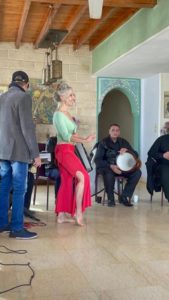 unless the song has already become a standard favourite that is bound to be requested a lot they are unlikely to have rehearsed it. The same goes for a mise en scene/mejancee: don’t expect the average live band – even in Cairo – to know the music from a CD produced in the last 30 years, unless they work with a dancer who regularly uses it. Popular ‘classic’ mejancees such as ‘Set el Hosn’ or ‘Aziza’ are still, amazingly, the ones most likely to be known by Egyptian or Lebanese bands everywhere. They never seem to get old.
unless the song has already become a standard favourite that is bound to be requested a lot they are unlikely to have rehearsed it. The same goes for a mise en scene/mejancee: don’t expect the average live band – even in Cairo – to know the music from a CD produced in the last 30 years, unless they work with a dancer who regularly uses it. Popular ‘classic’ mejancees such as ‘Set el Hosn’ or ‘Aziza’ are still, amazingly, the ones most likely to be known by Egyptian or Lebanese bands everywhere. They never seem to get old.
Modern shaabi songs require a good keyboard that emulates the production sound of ‘maharagan’ songs – most of which are only produced on a keyboard anyway. If the band you are working with doesn’t have one of these it’s not going to sound great. And to sing in shaabi or maharagan style also takes a certain kind of vocalist. On the plus side, if all you have is a keyboard player (which can often happen!) with a rhythm box, then he may well be able to produce a street shaabi sound better than a classical band.
Beginnings and endings
No matter what music you choose and agree to with the band, nothing matters more than your entrance and how you finish. If you are lucky enough to be performing a whole set (in Cairo this can last up to an hour!) you can plan a range of styles, moods and ideas for a complete show. But if you are performing just one piece of music, every minute counts and you have less time to make an impact. This certainly doesn’t mean you should rush onto the stage and try to perform lots of showy technique as fast as possible. But your first appearance is very important and should look professional. This means arranging with the musicians how and at what point you will appear. Often they will play a pre- introduction while you are off stage (many classic mejancees have one of these already in them), announce your name, and then you will come in with a travelling step at the ‘lead in’ point in the music. This gives a strong dynamic feel to your entrance and allows you to make an introductory sweep of the stage, acknowledging the audience. You can then arrange to move continuously into the music, or to do a dramatic spin, stop and ‘begin’.
If there is no obvious pre-intro, the musicians can play the opening bars of the song, then give you a drum break of four or eight counts for you to come in with, and carry on into the song once you are on stage. This is known in Arabic as an ‘arrbaa’ (which just means four). Having them play before you appear obviously builds anticipation for the audience – something which Cairo dancers are notorious for, sometimes letting the band repeat the intro music ten times before they deign to make their entrance!
If you are confident enough to carry yourself onto the stage without music and start on stage, this can also work dramatically. In this case the dramatic tension for the audience comes from not knowing what you are about to do. You can stand in front of them allowing them time to take in your gorgeous costume and overall magnetism, before launching into the first bars of beautiful music. This works for a section of tarab song which starts slowly; an example could be ‘Lissa Fakir’.
If you don’t want the awkwardness of a silent walk-on, and if the lighting is good enough, you can have a blackout and be already standing on stage as the lights come up. This though is more likely to be in a theatre situation where you can pre-arrange it with the lighting technician.
The ending is just as – if not more – important, since it’s the last thing you leave your audience with. There are different ways of ending your performance, and you don’t need a rehearsal to communicate what you want to the band. But you must have the conversation. The two main endings are known as the ‘pirouette’ and the ‘cut’. The ‘pirouette is pretty self explanatory, and just means they draw out the final note and you spin until you stop – and they stop with you. You don’t stop with them. You decide and they will follow. A notorious sign of the dancer’s lack of experience is when she keeps on spinning waiting for them to stop, as they wait for her…you can imagine the result. The ‘cut’ is preferable but sometimes requires a rehearsal, or at least ask them to sing the final phrase before you go on so you are in agreement. Lots of songs have a natural ‘cut’ ending, and it looks neater and more professional.
In Between
During your performance try forget whatever choreography you might have worked on to the song they are playing, and to instead actively listen to what they are playing. This where the letting go comes in. Try, even before you get on stage, to at least make a good connection with the tabla player, so he is on your side. Let him know that you want him to follow your accents when you make them (not the other way round.) To help with this process, don’t be afraid to make eye contact with him during the performance, even if this means turning your back on the audience. You really need to do this to keep him focused on you. There is nothing more annoying than noticing that the drummers are not even looking at you, but you have to be pro-active within this relationship, especially if they haven’t worked with you before.
Your own experience in terms of training; understanding rhythms and how to transition them smoothly; how to decide in the moment whether to go with rhythm or melody, these are stages that come with your experience.
 But no matter what happens on stage, and whether it’s your first or hundredth time dancing to live music, there will be a sense of exhilaration, an energy level you can’t beat, and an immersion into the music, that you will not feel dancing to a recording. And this is the living expression of oriental dance at its best!
But no matter what happens on stage, and whether it’s your first or hundredth time dancing to live music, there will be a sense of exhilaration, an energy level you can’t beat, and an immersion into the music, that you will not feel dancing to a recording. And this is the living expression of oriental dance at its best!
You can put this into practice with Yasmina – and learn more about dancing with live music at Summer School – starts 19th August: It is not too late to book.
Or sign up to Bellydance Music Explored, our online music course which will inform how you dance forever.
Yasmina began her dance career on the Arab and Greek nightclub stages of London during the 1980’s, danced around the Middle East in the 1990’s, and has been based in Cairo since 1995 where she performed nightly for eight years with her orchestra. She runs the Belly Dancers’ B&B in Cairo, hosts dance groups, gives workshops with live music and teaches around the world. She has also produced seven music CD’s in Cairo for dancers available here: yasminaofcairo.bandcamp.com
Yasmina is a founding director of Bellydance Now, and a teacher on the Bellydance Now Music Course
Emad el Rashidi
July 19th, 2022I have known Emad for many years and initially met him through Sara Farouk. He is a quietly spoken gentleman. Unassuming and interested in everything around him. Emad has taught several of my groups to sing Arabic songs and he has the patience of a saint. With Sara he also produced dancers versions of classics, editing the original songs. These are a great resource and for a dancer, have the atmosphere and orchestral arrangement of the original which is wonderful to dance to.
Emad was born in Cairo and loved music from an early age. The first instrument he learnt to play was a mouth organ. When he was about 10, his father bought an oud which he intended to learn to play himself ……. he never did. Instead Emad got hold of it and taught himself to play. The first song he learnt was ‘Enta Omri’, a great classic. One of the phrases within Enta Omri is often used to tune the oud …. so Emad jokes that he learned to tune an oud before he could play one.
It was at Ein Shams university when everything changed. His father insisted he study commerce BUT there is a great music faculty there and Emad made use of this to study his passion. They had a whole range of instruments which Emad worked his way through – but stuck with the oud as his principle instrument. He studied in the library, learnt the scales and maqam. They fascinated him so much that he studied how the maqam were used in several different Middle Eastern countries. Against lots of competition, he became the conductor of the Ein Shams orchestra. He sees this and his time at the university as the stepping stones to his musical career.
When he left university in 1975, he met up with other musicians who were going as a band to work at a club in London. Emad 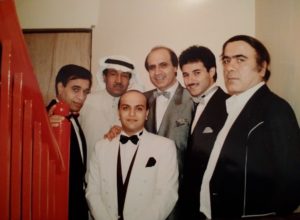 joined them and so moved to London. The club they had been hired by only lasted a month but they got work at the Ali Baba and then the Abu Nawas. He said people would go first to the Omar Khayyam and then go onto one of the clubs he played at. It was all great experience – and good money. Whilst in London, he also studied at the Thames Valley college of music where he got his one and only musical qualification! Emad loves to study …. if it is something that takes his interest he finds out everything he can.
joined them and so moved to London. The club they had been hired by only lasted a month but they got work at the Ali Baba and then the Abu Nawas. He said people would go first to the Omar Khayyam and then go onto one of the clubs he played at. It was all great experience – and good money. Whilst in London, he also studied at the Thames Valley college of music where he got his one and only musical qualification! Emad loves to study …. if it is something that takes his interest he finds out everything he can.
 After 4 years in London, Emad moved back to Cairo and started work at the Cairo Opera House. He taught courses in music and singing. He built up an 80 strong orchestra and choir. They built up a really impressive reputation. Some of the participants went on to become actors who have become household names.
After 4 years in London, Emad moved back to Cairo and started work at the Cairo Opera House. He taught courses in music and singing. He built up an 80 strong orchestra and choir. They built up a really impressive reputation. Some of the participants went on to become actors who have become household names.
Emad has composed for many singers including Ali Haggar and Mohamed El Helw. For 5 years he composed the music for the annual victory celebration attended by Hosny Mubarak and many other dignitaries. Emad composed music for over 35 plays as well as several TV shows.
‘What is the highlight of your musical career?’ I asked. The 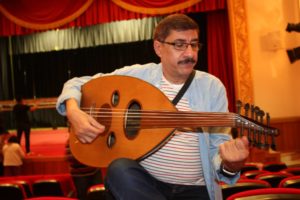 studying, he told me. When Emad finds something that fascinates him, he studies everything about it. Music fascinated him and through long hours of study and practical application, he has become an acknowledged expert in the field of Arabic music. That degree in commerce didn’t do him much good – but his time at Ein Shams university changed his life.
studying, he told me. When Emad finds something that fascinates him, he studies everything about it. Music fascinated him and through long hours of study and practical application, he has become an acknowledged expert in the field of Arabic music. That degree in commerce didn’t do him much good – but his time at Ein Shams university changed his life.
Emad is currently taking some time out and is based in Manchester. He does some lecturing at the university there and coaches a few students studying Arabic music.
As an aside, Emad told me he loves pasta so has been studying all about pasta – it’s history, all the different types, how to make it and more ……… we never stop learning!
Join me, Kay Taylor and Emad el Rashidi on Sunday 14th August at 4pm for a Zoom lecture on Arabic scales or maqam. Book your place on ‘Understanding Maqam’.
If you subscribe to ‘Bellydance Music Explored’ you can attend this lecture for free as part of the course. Your zoom link will be published on the FB group of that name.
How to master your breath during dance and performance
July 4th, 2022How to master your breath during dance and performance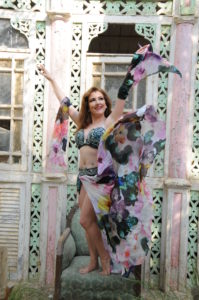
By Dorte Evelyn
It’s pretty obvious why we have to breath efficiently whilst dancing, but surprisingly little emphasis is often being put on how to do this correctly. Mastering this however will not only make your body function better, increase your stamina and therefore improve your overall performance, but it can also help you add extra power and drama into your performance.
The average person takes around 22,000 breaths a day with the waste majority of those will be done automatically and without any thought as to the effectiveness or quality of the individual breath. But any athlete using their body intentionally to performance their best must consider not only how they fuel their body with their breathing, but also on which techniques are used to achieve this.
The basics
Awareness of your breathing is the first step to improving it. Sounds simple, but it’s human nature for us to hold our breath when concentrating or learning new things, so in every single class I remind my students to breath. I also tend to start each class with a couple of deep breaths, so help focus the mind and get awareness into the body. And at the end, using the breath again to relax and prepare for the cool down.
On a basic level your breath fuels your muscles allowing them to work their best and helps you concentrate. But there are different ways of getting the oxygen that your body needs into your lunges and the waste products out again…
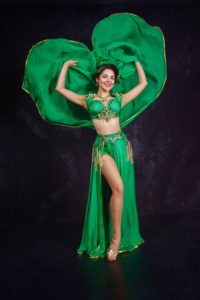 Breathing techniques
Breathing techniques
We can tap into different breathing techniques to help improve our performance when dancing. Initially your body will pick the one that it needs in that moment, but becoming more aware of your own breathing means that you can also switch between them as a matter of choice.
Applicable breathing
This type of breathing refers to when we’re mainly using the upper part of our lungs. This is how you’ll breath when going for a big run or otherwise exerting yourself physically. It’s great for when the body really needs to increase the amount of oxygen it gets, due to increased heart rate. But many people also breath like this when stressed, due to the fight or flight instinct.
You may end up breathing like this after doing a big solo or having done lots of jumps, but it’s not the ideal breathing technique for dancers, as it can utilise some of your neck muscles to lift and allow the chest to expand. Not to mention how impossible it would be for you to conduct upper body isolations whilst also breathing like this. So make sure you don’t use this as your standard breathing technique.
This type of breathing is mostly done with your mouth open.
Lateral breathing
Also called basal breathing, this is the most efficient way of breathing most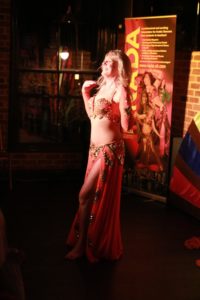 of the time when dancing. This is when you allow your lower ribs to expand and take in lots of air to fuel your body, but without it looking like your running a marathon and gasping for air (even if you may feel like you are!). If you’ve ever been told to breath through your ribs/ribcage, this is probably what they meant.
of the time when dancing. This is when you allow your lower ribs to expand and take in lots of air to fuel your body, but without it looking like your running a marathon and gasping for air (even if you may feel like you are!). If you’ve ever been told to breath through your ribs/ribcage, this is probably what they meant.
This types of breathing will allow your to relax your abdominal muscles, but also to switch your lower abs on with ease. This type of breathing can be controlled by breathing through the nose, but also through the mouth.
Abdominal breathing
Also sometimes called belly breathing, but this is not how a belly dancer should ideally breath… This type of breathing is great for singers because it allows the abs to release, and therefore the diaphragm to drop, increasing the air intake. It’s also a breathing technique sometimes used in yoga, although lateral breathing often is needed to perform moves where the abs are engaged.
Working with your breath
If you want to start controlling your breathing consciously then start by breathing in and out through your nose and feel how your lower ribs expand. Lateral means side, so to feel and practice your ‘side breathing’ by placing your palms on the side of your ribs and feel how the lungs flair out on the inhale and back in on the exhale. Try it lying down with one hand on the top of your belly/lower ribs and one hand on the side; you should feel the distance between your rips grow and hand on the side being pushed away slightly.
Please don’t start hyper ventilating! Breathing deeply should be done slowly and relaxed. Breathing in on a count of three and out on a count of 4/5 is great for practicing the control of your breath. Extending your exhale period can also be a great relaxation technique in its own right, for example inhaling on 3/4 and out on 8.
If you’re just starting to get to grips with your controlled side-breathing, then make sure to ask your teacher or dance mentor to keep an eye on you in class. If you’ve already got the basics, then try mixing the different  techniques up to see how they feel. That way you will hopefully be able to stop yourself when you start breathing at the top of your chest halfway through class. You may also discover that it doesn’t work to apply abdominal breathing whilst doing certain moves – mainly because you lose control of your core and basic posture.
techniques up to see how they feel. That way you will hopefully be able to stop yourself when you start breathing at the top of your chest halfway through class. You may also discover that it doesn’t work to apply abdominal breathing whilst doing certain moves – mainly because you lose control of your core and basic posture.
Bottomline is, try to maintain lateral breathing even when you start increasing your heart rate. Your chest may start rising too, but if you didn’t breath deeply into your lungs at the same time, your chest would rise and fall even more, making it difficult to achieve control of posture and isolations.
Using your breath during performance
There are many ways you can add oomph and drama to your performance by using your breath.
As a general rule – never hold your breath – because as you’ve already learned it will mean your body can’t perform at it’s best. But also, when you do, so does your audience! So maybe you do want to hold it – just a second or two, whilst you role your shoulder, circle your chest or similar… But don’t forget to only use it sparingly and intentionally to add drama and suspense.
Flutters of the diaphragm (belly flutter) are another reason why you may want to hold your breath, but make sure you practice this carefully. There are so many elements to this, and a blog or workshop in its own right.
I hope you’ll enjoy working consciously with your breath to improve your performance and dancing.
Happy and beautiful dancing always.
Dorte
To develop your performance skills, you might want to consider some of the following:
JWAAD Summer school with various performance opportunities and ’15 minutes’ of fame – individual feedback for those who register on the professional development stream.
Or the ‘Bellydance Now International Challenge 2023’ Our BDNIC is already in full swing for 2022 – you might want to consider joining us next year. This link is to the information about BDNIC 2022. Have a look and watch out for next years competition. If you are interested in seeing the final of this years BDNIC, come to the Gala show at Fantasia – 26th November 2022.
About the author:
Dorte Evelyn is an international dancer, teacher and performer and member of the ‘Bellydance Now’ team as well as the founder of the Ishtar Dance Academy. She is mentor on the Bellydance Now International Challenge as well as tutor on the JWAAD Safety to Bellydance Course. (link to course)
